General Questions of Strep Throat Symptoms
Many people have experiences with strep throat infections. It's one of the most common bacterial culprit among people, only behind sore throat infections. For its becterial infection nature, antibiotic is needed to treat the strep throat infections effectively. To avoid generation of other syndroms, one have to get cured correctly and immediately when strep throat symptoms appear.
Here are the most asked questions of strep throat symptoms.
1. How to identify a strep throat
Tipical strep throat symptoms includes:

- A rapid and long lasting fever(longer than 48 hours). For older children, if a fever is higher than 101F(38.3℃), that also can be a signal for strep throat;
- A rapid and severe sore throat but no typical cold symptoms, like sneezing, running nose and cough;
- A sore throat accompanied by tender, swollen glands (lymph nodes) beneath the jaws;
- Seen on the tonsils and throat, there are white or light yellow spots or patches.
- Bright red throat or dark red spots on the roof of the mouth at the back near the throat.

Besides these tipical strep throat sympthoms, other more non-specific signals and symptoms, such as headache, painful swallowing, difficult breathing, abdominal pain or rash, may also appear.
If you have any of the typical symptoms, it's definitely time to see your doctor.
A doctor can often do a rapid strep test right in the office. He or she will use a swab to take a sample of the fluids at the back of your throat. It usually only takes about 5 minutes to find out if you've got strep throat. If the rapid test is normal, the doctor will probably send a sample to a lab for a throat culture, just to make sure. Throat culture results are usually back within about 2 days.
2. Is strep throat infectious?
The answer is yes. Strep throat infection is passed from person to person by close physical contact. The bacteria that cause strep throat tend to hang out in the nose and throat, so strep throat can be transmission by spittle with a cough or sneeze. Becterial has exuberant vitality and can live for a long period, which only leads the infection spread easier and faster. Thus spread through food-borne outbreaks is also possible, although it is less common.
People work in a crowded environment have higher rate for getting this infection. The risk of acquiring strep throat from an infected family member is also very high(near 40%!), since physical contact is hardly avoided.
Symptoms usually begin within 1-4 days after contracting the infection (the incubation period).
3. Is the strep throat only infected by children?
Children aged in 4-16 are most susceptible to strep throat. However, adults and younger childrens can also be infected. Generally speaking, strep throat symptoms can be rarely seen among children less than 1 year old or adults above 50 years old.

While almost all affected people got sore throat, which is similar, some of the general and constitutional symptoms of strep throat infection may vary quite a bit depending on the patient's age.
- Children aged 1-3 years old may suffer from a sore throat, trouble swallowing, poor appetite and swollen lymph glands (nodes) on the sides of the neck;
- For older children and adolescents(aged 4-16), they commonly have terrible look and feel with strep throat. They also may get high fevers, very painful throats accompany with severe difficult swallowing, and pus on the tonsils.
- Generally speaking, strep throat symptoms in adults is milder than children and adolescents. But symptoms very; For some adults, the illness maybe undetected; for others, they may also have severe pain and trouble swallowing.
4. How to differentiate a strep throat and a cold and does the strep throat come with a cold?
No. Actually, the more cold symptoms you have, the less likely you got strep infection. As mentioned above, when people infected with strep throat, they are likely to get rapid and severe sore throat. However, they usually don't get cough. All other cold symptoms such as sneezing, or a running nose are unlikely occur with strep infection. With this knowledge, we can easily differentiate a cold from a strep throat.
5. How to avoid catching a strep throat

The bacteria that cause strep throat tend to hang out in the nose and throat, so sneezing, coughing, or shaking hands can easily spread the strep infection from one person to another. That's why it's so important to wash your hands as often as possible.
To reduce our chances of acquiring strep throat, we need keep a distance from the infected person. The infection rates will increase when our body in bad conditions. Therefore, it's important for us to have a healthy diet, rich in fruits and vegetables. Also make sure that we get enough sleep and keep enough exercise everyday.